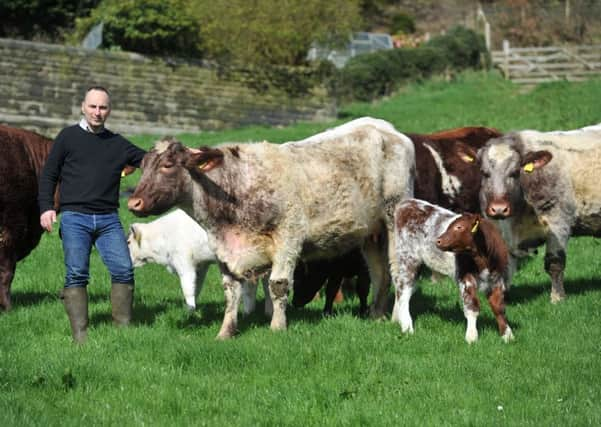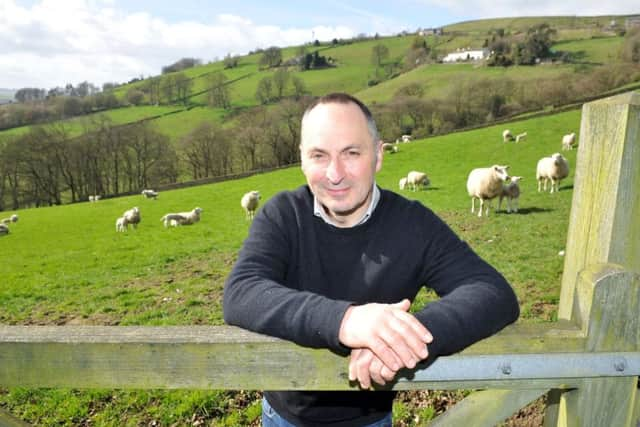Tim Riley's pursuit of the perfect beef cuts


Tim Riley’s early career didn’t exactly follow on from this weightier reading materials. He’d studied molecular genetics at university and had worked in a senior post in the Department of Health, but a move that saw him relocate to Yorkshire in his early 30s subsequently brought about his farming aspirations. He purchased the 50-acre Stoney Royd Farm in Midgley between Hebden Bridge and Halifax in 1992 with his wife Amanda, who hails from Todmorden, and through his Beef Shorthorn herd and Lleyn flock has earned respect in these breed sectors.
“I’d always wanted to farm. My mother’s side of the family continue to farm in East Anglia. I think she always thought I’d become a farmer eventually and being given the Farmers Weekly when I was so young was perhaps an indoctrination.”
Advertisement
Hide AdAdvertisement
Hide AdBeef Shorthorn cattle have become Tim’s passion. He’s recently been invited on to the breed society’s board and believes that the current move towards quality, flavoursome mature native beef consumption will provide further impetus for both himself and his fellow breeders.


“The Beef Shorthorn is the closest we have to an indigenous Yorkshire breed and I wanted to produce an animal that could be commercial but also fitted well to the rapidly emerging quality meat market. Rearing native breeds that require less inputs also helps brings about better marbling.
“I started with them in 2008 and we are just about getting to something that I’m almost happy with. I’ve kept pushing and improving the genetics all the time and we have seen the length of our cattle increase as well as the width of the top line. I selected foundation stock that would work on quite difficult ground as that’s what we have here. We run between 600-1,000ft above sea level so this is a hill farm good and proper.
“What I’m aiming for is to standardise our look, our own style so that every breeder can tell what they are looking at is a Stoney Royd.
Advertisement
Hide AdAdvertisement
Hide Ad“We’re breeding for replacement stock for ourselves and for other breeders, we’re breeding for commercial beef producers, butchers and for what ends up becoming great tasting, well marbled, natural beef. Producing replacement heifers is our principal aim as well as stock bulls and steers for the meat market.


“We are also currently thinking of how we can use the older cows better to maximise our returns through dry-aged beef for a niche restaurant market.
“Although it hasn’t been my main goal we have done quite well with our breeding bulls and sold one last year to the National Breeding Centre for Ireland. I’m really pleased it has gone on to be a major stud bull. It’s another example of how we are improving the quality of our cattle quite significantly and the number of bulls that we’re finding worth bringing on has increased in line with that improvement.”
Tim utilises a mixture of bought-in bulls and AI.
“I purchased a very high index, high performance bull from a sale at Stirling last year and he has produced some cracking calves. It has provided a good mix with some of our Canadian lines.”
Advertisement
Hide AdAdvertisement
Hide AdThe herd presently runs to 26 head of stock with 12 suckler cows calving this year. One or two of the males that don’t come up to Tim’s standards are sold entire at 12 months for others to fatten. He has very few heifers that fail to make the grade and has also had success at shows in Driffield, Halifax and Todmorden - but he still feels he isn’t quite ready yet for competing at the Great Yorkshire.
“Producing the best stock possible is what drives me. I’m looking for perfection or as near as I can get and that’s why I’m not showing at Harrogate maybe until next year. We’ve done okay so far and the breed champion we had at Todmorden was the one we sold to Ireland, but I’m also aware that what is going to make a fantastic show animal is not necessarily the best breeding animal. It’s still a great feeling when you win though!”
Tim’s belief that mature Beef Shorthorn on the plate has a great niche market future was buoyed recently when a neighbour passed him the biggest compliment he has received outside of the breeding world.
“We scan all of our animals for eye muscle and marbling. The older the animal gets the more tender and flavoursome its meat becomes through the marbling. We sold some of our own Beef Shorthorn meat privately and locally for the first time last year and the reaction we had from one villager was great, the best beef they’d ever tasted and could we produce more.”
Advertisement
Hide AdAdvertisement
Hide AdWhen Tim first arrived at Stoney Royd he started with a small flock of sheep. He built up a Lleyn flock to around 150 breeding ewes that now runs to 40.
“We focus on the pedigree Lleyn market and have very good repeat customers. The Lleyns are the whole package in one. They produce a decent butchers’ lamb, they are fantastic ewes that will raise twins and are good hardy sheep. We’re reasonably well known for the style we produce as we breed for length, hardiness and mothering ability. We’re also absolutely ruthless and anything that doesn’t perform goes off to market.”
Clearly Tim’s early reading has stood him in good stead at Stoney Royd. He is fixed on his targets of producing quality stock, quality meat and making his farm work.
“The whole point has been that this has never been a hobby, even though I have had another career. This has always been and always will be about running it as a commercial entity. We’re doing that and the Beef Shorthorns are increasingly playing their part. There is a really good future for the breed.”
FARM’S HISTORY
Advertisement
Hide AdAdvertisement
Hide AdStoney Royd Farm and farmhouse is steeped in history. The original farmhouse was built in the 14th century. It was rebuilt in 1715 for the marriage of John and Mary Farrar. The Farrar family owned a significant amount of land around Midgley and is still a family name synonymous with the village today.
Tim grew up in County Armagh, Ireland before moving to England with his parents and he studied at King’s College, Cambridge.
He sourced his initial Beef Shorthorn stock from fellow Yorkshire breeders Rob Paisley of West Moor Farm, Middleton near Ilkley and Gerald Turton’s Upsall herd at Upsall Castle.